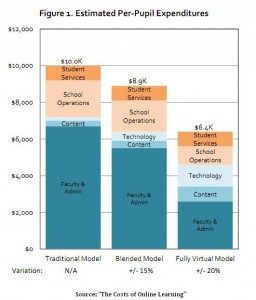The Value of Online and Blended Learning
Education Domain Blog
There is a general lack of information available when it comes to determining the costs associated with online and blended learning. Yet, at a time when all state legislatures and education agencies are wrestling with funding issues, accurate cost data is essential.
A new report released this week by the Thomas B. Fordham Foundation takes a closer look at those costs, showing a range of figures based on the different program options offered to students of K-12 education in the U.S.
Comparing the costs of online and blended learning programs (both full and part-time) to those associated with traditional brick-and-mortar schooling (which varies school by school, state by state and district by district) presented the report’s authors with an important and difficult challenge.
The Foundation’s new report is a serious effort to look into the cost drivers for online and blended programs. Much of its reporting is based on in-depth interviews with a number of sources. It provides useful insights that will help to foster a better understanding of resource allocations in education, not only for those within our field, but also for the policymakers who need to make equitable and sound funding decisions that affect students in online and blended learning programs across the country.
The report also touches on the proper role of technology in education – driving innovation in learning models, rather than being bolted on to traditional models that aren’t working. Exploring innovation is an important topic – and we might think of “innovation in instructional models” and “innovation in cost/funding models” as two areas, that may or may not intersect. We also want to affirm the report’s statement that any investment in classroom technology should be tied to its ability to improve student outcomes.
Nonetheless, it is important to note a few key points that will help to ensure the report serves as a useful resource for our field, as online and blending learning continues to grow at a rapid pace.
A 2010 Wisconsin Joint Legislative Audit found that costs of full-time online learning programs in Wisconsin averaged $6,500 per pupil. In particular, in the actual figures provided in this new report, the summary of the study’s conclusions claims that the costs of online learning programs can average as low as $5,100 per student. This number is far too low. In fact, if you thumb through the actual report, you find that programs usually run closer to $6,400 per student at the lower end, with some variability. (See Figure 1 from the report.)
In any case, claims that per-student costs could approach these numbers could be dangerous, because they may encourage school districts and other authorities looking for online learning solutions to sacrifice the quality of education for cost. The largest costs in online learning programs, blended learning programs and traditional education programs are faculty and people. So while important funding decisions do need to be made, these decisions must reflect a better understanding of the cost drivers and the “average costs” necessary to provide high-quality and cost-efficient online education for all students with people providing support. Online and blended learning can help students access the best teachers to provide personalized instruction to meet individual student needs.
Overall, the focus of our efforts should be on student outcomes, results and success. State legislators and education policymakers should work to ensure that not only does their funding enable them to provide students with the opportunity to learn online, but also that it provides every student with the opportunity to access a world-class education.
